A Holistic Approach to the Evaluation of the Montado Ecosystem Using Proximal Sensors
Abstract
:1. Introduction
1.1. Montado Ecosystem: Importance and Decline Signs
1.2. Complexity of Montado Evaluation
1.3. Contribution of Precision Agriculture to the Sustainability of the Montado
2. Material and Methods
2.1. Site Characteristics
2.2. Experimental Methodology
2.2.1. Digital Elevation Survey
2.2.2. Apparent Soil Electrical Conductivity (ECa) Survey
2.2.3. Soil Moisture Content (SMC) Measurements
2.2.4. Pasture Photosynthetically Active Radiation (PAR) Measurements
2.2.5. Pasture Surface Temperature Measurements
2.2.6. Pasture Biomass Estimation Using “Grassmaster II” Capacitance Probe
2.2.7. Pasture Vegetation Index (NDVI) Measurement using “OptRx” Sensor
2.2.8. Pasture Sample Collection and Analysis
2.2.9. Animal Tracking with GPS Receivers
3. Results and Discussion
3.1. Altimetry and ECa Maps
3.2. Tree Influence on Pasture Productivity and Quality
3.3. Sensors Contribution to Understanding Tree Influence on Pasture Productivity and Quality.
3.3.1. Soil Moisture Content Profiles
3.3.2. Effect of Photosynthetically Active Radiation (PAR) on Pasture Productivity
3.3.3. Pasture Surface Temperature Measurements
3.3.4. Proximal Sensor for Estimating Pasture Productivity
3.3.5. Proximal Sensor for Estimating Pasture Quality
3.3.6. Animal Tracking
3.3.7. Contribution of This Study to Montado Ecosystem Management
4. Conclusions
Acknowledgments
Author Contributions
Conflicts of Interest
References
- Ferraz-de-Oliveira, M.I.; Azeda, C.; Pinto-Correia, T. Management of montados and dehesas for high nature value: An interdisciplinary pathway. Agrofor. Syst. 2016, 90, 1–6. [Google Scholar] [CrossRef]
- Garrido, P.; Elbakidze, M.; Angelstam, P.; Plieninger, T.; Pulido, F.; Moreno, G. Stakeholder perspectives of wood-pasture ecosystem services: A case study from Iberian dehesas. Land Use Policy 2017, 60, 324–333. [Google Scholar] [CrossRef]
- Pinto-Correia, T.; Ribeiro, N.; Sá-Sousa, P. Introducing the montado, the cork and holm oak agroforestry system of Southern Portugal. Agrofor. Syst. 2011, 82, 99. [Google Scholar] [CrossRef]
- Almeida, M.; Azeda, C.; Guiomar, N.; Pinto-Correia, T. The effects of grazing management in montado fragmentation and heterogeneity. Agrofor. Syst. 2016, 90, 69–85. [Google Scholar] [CrossRef]
- Godinho, S.; Guiomar, N.; Machado, R.; Santos, P.; Sá-Sousa, P.; Fernandes, J.P.; Neves, N.; Pinto-Correia, T. Assessment of environment, land management, and spatial variables on recent changes in montado land cover in southern Portugal. Agrofor. Syst. 2016, 90, 177–192. [Google Scholar] [CrossRef]
- Sales-Baptista, E.; Cancela d’Abreu, M.; Ferraz de Oliveira, M.I. Overgrazing in the montado? The need for monitoring grazing pressure at paddock scale. Agrofor. Syst. 2016, 90, 57–68. [Google Scholar] [CrossRef]
- Schellberg, J.; Hill, M.J.; Roland, G.; Rothmund, M.; Braun, M. Precision agriculture on grassland: Applications, perspectives and constraints. Eur. J. Agron. 2008, 29, 59–71. [Google Scholar] [CrossRef]
- Nawar, S.; Corstanje, R.; Halcro, G.; Mulla, D.; Mouazen, A.M. Delineation of soil management zones for variable-rate fertilization: A review. Adv. Agron. 2017, 143, 175–245. [Google Scholar]
- Moeckel, T.; Safari, H.; Reddersen, B.; Fricke, T.; Wachendorf, M. Fusion of ultrasonic and spectral sensor data for improving the estimation of biomass in grassland with heterogeneous sward structure. Remote Sens. 2017, 9, 98. [Google Scholar] [CrossRef]
- Ferraz de Oliveira, M.I.; Lamy, E.; Bugalho, M.N.; Vaz, M.; Pinheiro, C.; Cancela d’Abreu, M.; Capela e Silva, F.; Sales-Baptista, E. Assessing foraging strategies of herbivores in Mediterranean oak woodlands: A review of key issues and selected methodologies. Agrofor. Syst. 2013, 87, 1421–1437. [Google Scholar] [CrossRef]
- Castrignanò, A.; Buttafuoco, G.; Quarto, R.; Vitti, C.; Langella, G.; Terribile, F.; Venezia, A. A combined approach of sensor data fusion and multivariate geostatistics for delineation of homogeneous zones in an agricultural field. Sensors 2017, 17, 2794. [Google Scholar] [CrossRef] [PubMed]
- Zhang, Y.; Xiao, Y.; Zhuang, Z.; Zhou, L.; Liu, F.; He, Y. Development of a near ground remote sensing system. Sensors 2016, 16, 648. [Google Scholar] [CrossRef] [PubMed]
- Safari, H.; Fricke, T.; Reddersen, B.; Mockel, T.; Wachendorf, M. Comparing mobile and static assessment of biomass in heterogeneous grassland with a multi-sensor system. J. Sens. Sens. Syst. 2016, 5, 301–312. [Google Scholar] [CrossRef]
- Pullanagari, R.R.; Yule, I.J.; Tuohy, M.P.; Hedley, M.J.; Dynes, R.A.; King, W.M. Proximal sensing of the seasonal variability of pasture nutritive value using multispectral radiometry. Grass Forage Sci. 2013, 68, 110–119. [Google Scholar] [CrossRef]
- Yule, I.; Pullanagari, R.; Irwin, M.; McVeagh, P.; Kereszturi, G.; White, M.; Manning, M. Mapping nutrient concentration in pasture using hyperspectral imaging. J. N. Z. Grassl. 2015, 77, 47–50. [Google Scholar]
- Modica, G.; Solano, F.; Merlino, A.; Di Fazio, S.; Barreca, F.; Laudari, L.; Fichera, C.R. Using Landsat 8 imagery in detecting cork oak (Quercus suber L.) woodlands: A case study in Calabria (Italy). J. Agric. Eng. 2016, 47, 205–215. [Google Scholar] [CrossRef]
- Edirisinghe, A.; Hill, M.J.; Donald, G.E.; Hyder, M. Quantitative mapping of pasture biomass using satellite imagery. Int. J. Remote Sens. 2011, 32, 2699–2724. [Google Scholar] [CrossRef]
- Hassan-Esfahani, L.; Ebtehaj, A.M.; Torres-Rua, A.; McKee, M. Spatial scale gap filling using an unmanned aerial system: A statistical downscaling method for applications in precision agriculture. Sensors 2017, 17, 2106. [Google Scholar] [CrossRef] [PubMed]
- Handcock, R.N.; Gobbett, D.L.; González, L.A.; Bishop-Hurley, G.J.; McGavin, S.L. A pilot project combining multispectral proximal sensors and digital cameras for monitoring tropical pastures. Biogeosciences 2016, 13, 4673–4695. [Google Scholar] [CrossRef]
- Poblete, T.; Ortega-Farías, S.; Moreno, M.A.; Bardeen, M. Artificial neural network to predict vine water status spatial variability using multispectral information obtained from an unmanned aerial vehicle (UAV). Sensors 2017, 17, 2488. [Google Scholar] [CrossRef] [PubMed]
- Ribeiro-Gomes, K.; Hernández-López, D.; Ortega, J.F.; Ballesteros, R.; Poblete, T.; Moreno, M.A. Uncooled thermal camera calibration and optimization of the photogrammetry process for UAV applications in agriculture. Sensors 2017, 17, 2173. [Google Scholar] [CrossRef] [PubMed]
- Christiansen, M.P.; Laursen, M.S.; Jørgensen, R.N.; Skovsen, S.; Gislum, R. Designing and testing a UAV mapping system for agricultural field surveying. Sensors 2017, 17, 2703. [Google Scholar] [CrossRef] [PubMed]
- Manning, J.; Cronin, G.; González, L.; Hall, E.; Merchant, A.; Ingram, L. The behavioural responses of beef cattle (Bos Taurus) to declining pasture availability and the use of GNSS technology to determine grazing preference. Agriculture 2017, 7, 45. [Google Scholar] [CrossRef]
- Food and Agriculture Organization (FAO). World Reference Base for Soil Resources; World Soil Resources Reports Nº103; Food and Agriculture Organization of the United Nations: Rome, Italy, 2006. [Google Scholar]
- Serrano, J.; Shahidian, S.; Marques da Silva, J. Spatial and temporal patterns of apparent electrical conductivity: DUALEM versus Veris sensors for monitoring soil properties. Sensors 2014, 14, 10024–10041. [Google Scholar] [CrossRef] [PubMed]
- Facchi, A.; Baroni, G.; Boschetti, M.; Gandolfi, C. Comparing optical and direct methods for leaf area index determination in a maize crop. J. Agric. Eng. 2010, 1, 33–40. [Google Scholar]
- Serrano, J.; Shahidian, S.; Marques da Silva, J. Monitoring pasture variability: Optical OptRx® crop sensor versus Grassmaster II capacitance probe. Environ. Monit. Assess. 2016, 188, 117. [Google Scholar] [CrossRef] [PubMed]
- Serrano, J.; Shahidian, S.; Marques da Silva, J. Calibration of GrassMaster II to estimate green and dry matter yield in Mediterranean pastures: Effect of pasture moisture content. Crop Pasture Sci. 2016, 67, 780–791. [Google Scholar] [CrossRef]
- Serrano, J.; Peça, J.; Marques da Silva, J.; Shahidian, S. Calibration of a capacitance probe for measurement and mapping of dry matter yield in Mediterranean pastures. Precis. Agric. 2011, 12, 860–875. [Google Scholar] [CrossRef]
- AOAC. Official Methods of Analysis of AOAC International, 18th ed.; AOAC International: Arlington, VA, USA, 2005. [Google Scholar]
- Sales-Baptista, E.; Ferraz de Oliveira, I.; Santos, M.B.; Lopes de Castro, J.A.; Pereira, A.; Rafael, J.; Serrano, J. Low-cost GNSS technology for monitoring grazing sheep. Revista de Ciências Agrárias 2016, 39, 251–260. (In Portuguese) [Google Scholar] [CrossRef]
- Moral, F.; Terrón, J.; da Silva, J.M. Delineation of management zones using mobile measurements of soil apparent electrical conductivity and multivariate geostatistical techniques. Soil Tillage Res. 2010, 106, 335–343. [Google Scholar] [CrossRef]
- Guevara-Escobar, A.; Kemp, P.D.; Mackay, A.D.; Hodgson, J. Pasture production and composition under poplar in a hill environment in New Zealand. Agrofor. Syst. 2007, 69, 199–213. [Google Scholar] [CrossRef]
- Benavides, R.; Douglas, G.B.; Osoro, K. Silvopastoralism in New Zealand: Review of effects of evergreen and deciduous trees on pasture dynamics. Agrofor. Syst. 2009, 76, 327–350. [Google Scholar] [CrossRef]
- Hussain, Z.; Kemp, P.D.; Horne, D.J.; Jaya, I.K.D. Pasture production under densely planted young willow and poplar in a silvopastoral system. Agrofor. Syst. 2009, 76, 351–362. [Google Scholar] [CrossRef]
- Demanet, R.; Mora, M.L.; Herrera, M.A.; Miranda, H.; Barea, J.M. Seasonal variation of the productivity and quality of permanent pastures in Adisols of temperate regions. J. Soil Sci. Plant Nut. 2015, 15, 111–128. [Google Scholar] [CrossRef]
- Jackson, J.; Ash, A.J. Tree-grass relationships in open eucalypt woodlands of northeastern Australia: Influence of trees on pasture productivity, forage quality and species distribution. Agrofor. Syst. 1998, 40, 159–176. [Google Scholar] [CrossRef]
- Sousa, L.F.; Maurício, R.M.; Moreira, G.R.; Gonçalves, L.C.; Borges, I.; Pereira, L.G.R. Nutritional evaluation of ‘‘Braquiaro’’ grass in association with ‘‘Aroeira’’ trees in a silvopastoral system. Agrofor. Syst. 2010, 79, 189–199. [Google Scholar] [CrossRef]
- Somarriba, E. Pasture growth and floristic composition under the shade of guava (Psidium guajava L.) trees in Costa Rica. Agrofor. Syst. 1988, 6, 153–162. [Google Scholar] [CrossRef]
- Marcos, G.M.; Obrador, J.J.; Garcia, E.; Cubera, E.; Montero, M.J.; Pulido, F.; Dupraz, C. Driving competitive and facilitative interactions in oak dehesas through management practices. Agrofor. Syst. 2007, 70, 25–40. [Google Scholar] [CrossRef]
- Bird, P.R. Tree windbreaks and shelter benefits to pasture in temperate grazing systems. Agrofor. Syst. 1998, 41, 35–54. [Google Scholar] [CrossRef]
- Ren, Q.C.; Jin, X.; Zhang, Z.H.; Yang, H.J.; Li, S.L. Effects of dietary neutral detergent fibre to protein ratio on duodenal microbial nitrogen flow and nitrogen losses in lactating cows fed high-concentrate total mixed rations with different forage combinations. J. Agric. Sci. 2015, 153, 753–764. [Google Scholar] [CrossRef]
- Albayrak, S. Use of reflectance measurements for the detection of N, P, K, ADF and NDF contents in Sainfoin pasture. Sensors 2008, 8, 7275–7286. [Google Scholar] [CrossRef] [PubMed]
- Zhao, D.; Starks, P.J.; Brown, M.A.; Phillips, W.A.; Coleman, S.W. Assessment of forage biomass and quality parameters of bermudagrass using proximal sensing of pasture canopy reflectance. Grassl. Sci. 2007, 53, 39–49. [Google Scholar] [CrossRef]
- National Research Council. Nutrient Requirements of Sheep, 6th ed.; National Academy Press: Washington, DC, USA, 1985; Volume 5. [Google Scholar]
- Gómez-Rey, M.X.; Garcês, A.; Madeira, M. Soil organic-C accumulation and N availability under improved pastures established in Mediterranean oak woodlands. Soil Use Manag. 2012, 28, 497–507. [Google Scholar] [CrossRef]
- Pinchak, W.E.; Smith, M.A.; Hart, R.H.; Waggoner, J.W. Beef cattle distribution patterns on foothill range. J. Range Manag. 1991, 44, 267–275. [Google Scholar] [CrossRef]
- Serrano, J.; Peça, J.; Marques da Silva, J.; Shahidian, S. Mapping soil and pasture variability with an electromagnetic induction sensor. Comput. Electron. Agric. 2010, 73, 7–16. [Google Scholar] [CrossRef]
- Serrano, J.; Peça, J.O.; Marques da Silva, J.M.; Shahidian, S.; Carvalho, M. Phosphorus dynamics in permanent pastures: Differential fertilizing and the animal effect. Nutr. Cycl. Agroecosyst. 2011, 90, 63–74. [Google Scholar] [CrossRef]
- Serrano, J.; Shahidian, S.; Marques da Silva, J. Small scale soil variation and its effect on pasture yield in Southern Portugal. Geoderma 2013, 195–196, 173–183. [Google Scholar] [CrossRef]
- Serrano, J.; da Silva, J.M.; Shahidian, S. Spatial and temporal patterns of potassium on grazed permanent pastures-Management challenges. Agric. Ecosyst. Environ. 2014, 188, 29–39. [Google Scholar] [CrossRef]
- Serrano, J.; Shahidian, S.; Marques da Silva, J.; Sales-Baptista, E.; Ferraz de Oliveira, I.; Lopes de Castro, J.; Pereira, A.; Cancela de Abreu, M.; Machado, E.; Carvalho, M. Tree influence on soil and pasture: Contribution of proximal sensing to pasture productivity and quality estimation in montado ecosystems. Int. J. Remote Sens. 2017. [Google Scholar] [CrossRef]
- Serrano, J.; Peça, J.O.; Shahidian, S. Evaluation of variable rate technology for fertilizer application in permanent pastures. J. Agric. Sci. Technol. 2011, 489–499. [Google Scholar]
- Schaefer, M.T.; Lamb, D.W. A combination of plant NDVI and Lidar measurements improve the estimation of pasture biomass in Tall Fescue (Festuca Arundinacea Var. Fletcher). Remote Sens. 2016, 8, 109. [Google Scholar] [CrossRef]
- McCormick, S.; Jordan, C.; Bailey, J. Within and between-field spatial variation in soil phosphorus in permanent grassland. Precis. Agric. 2009, 10, 262–276. [Google Scholar] [CrossRef]
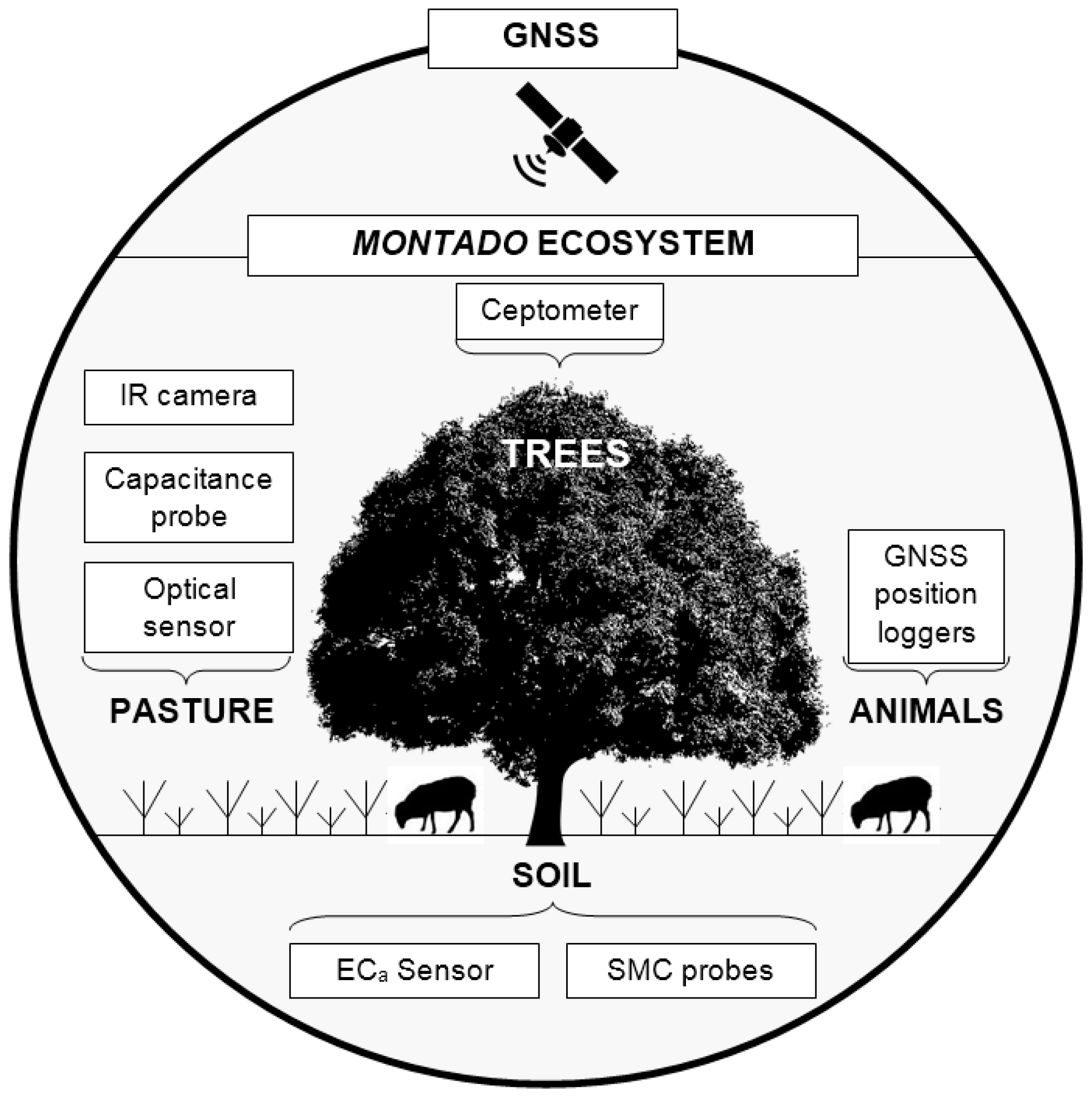
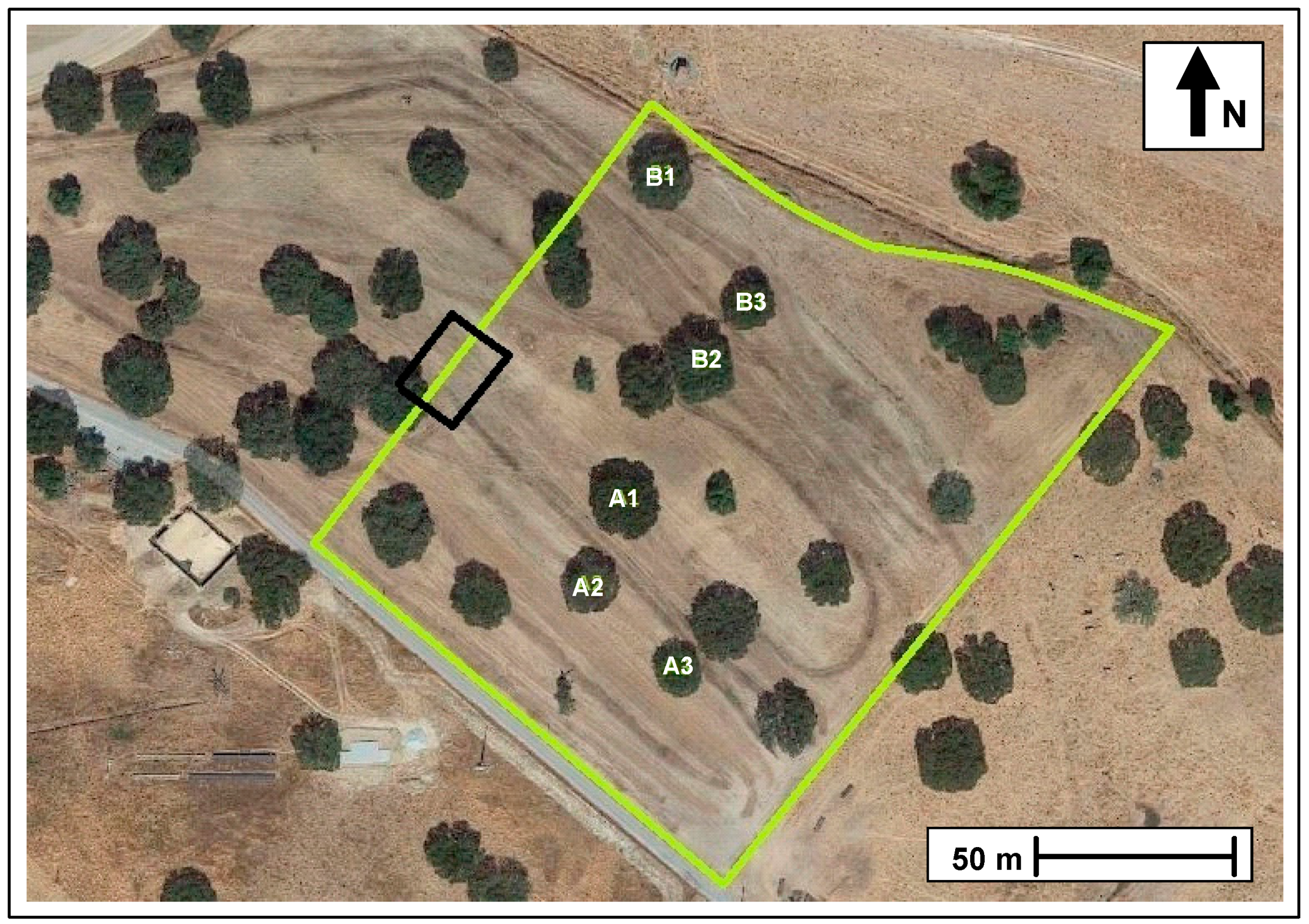
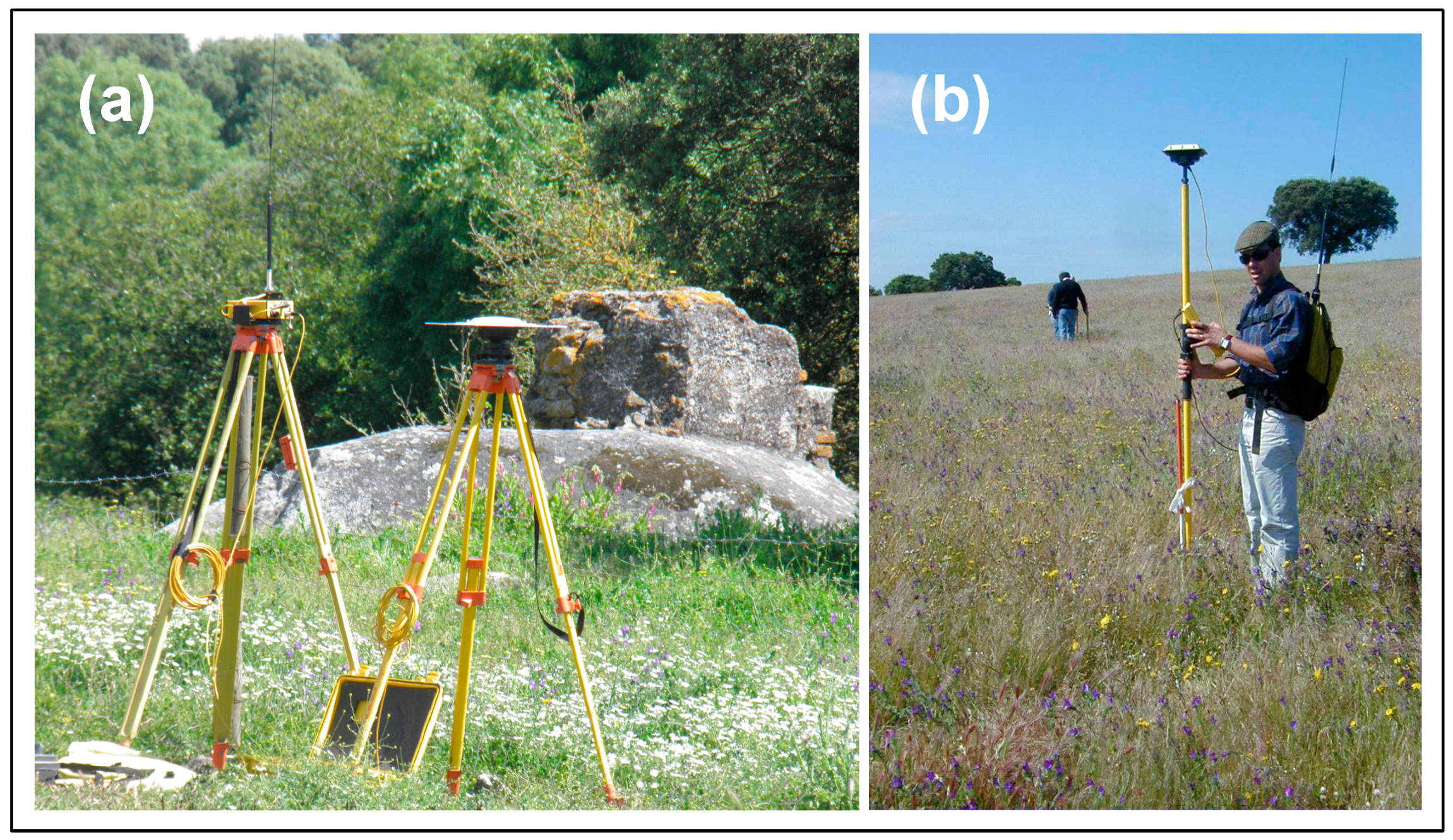
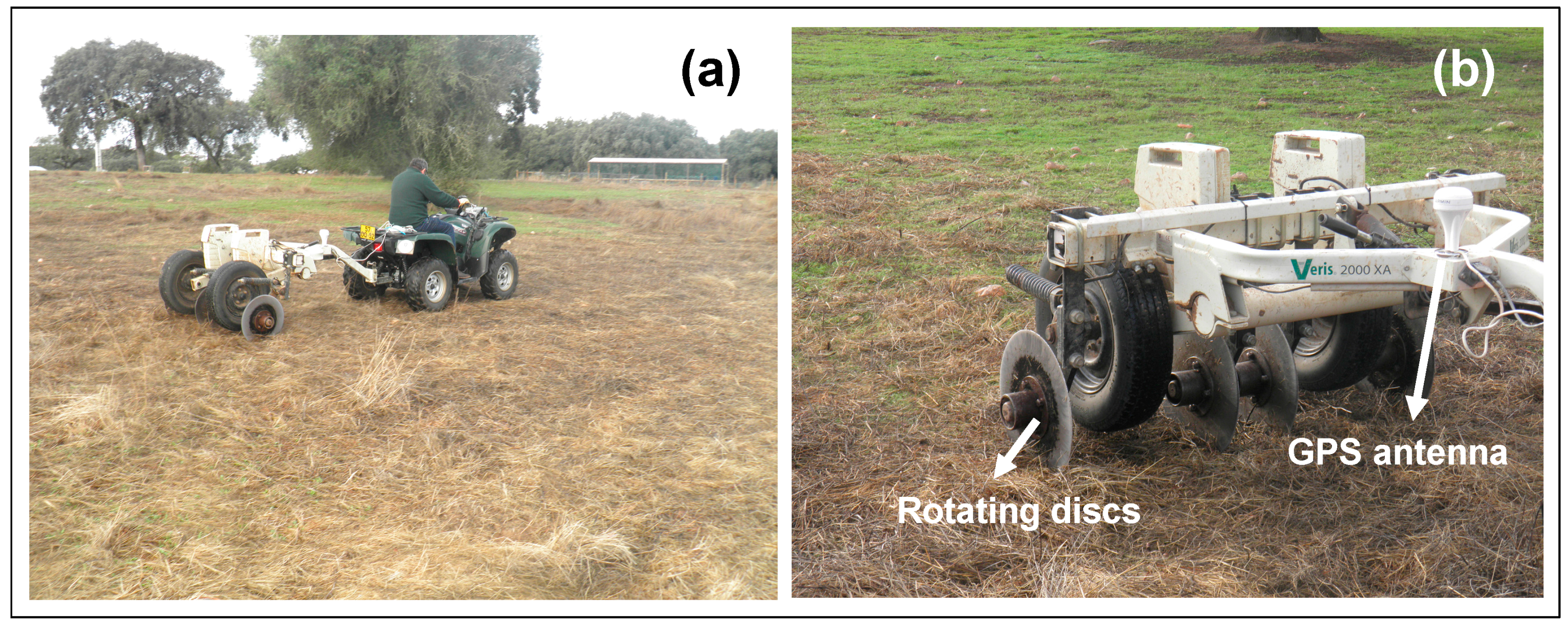
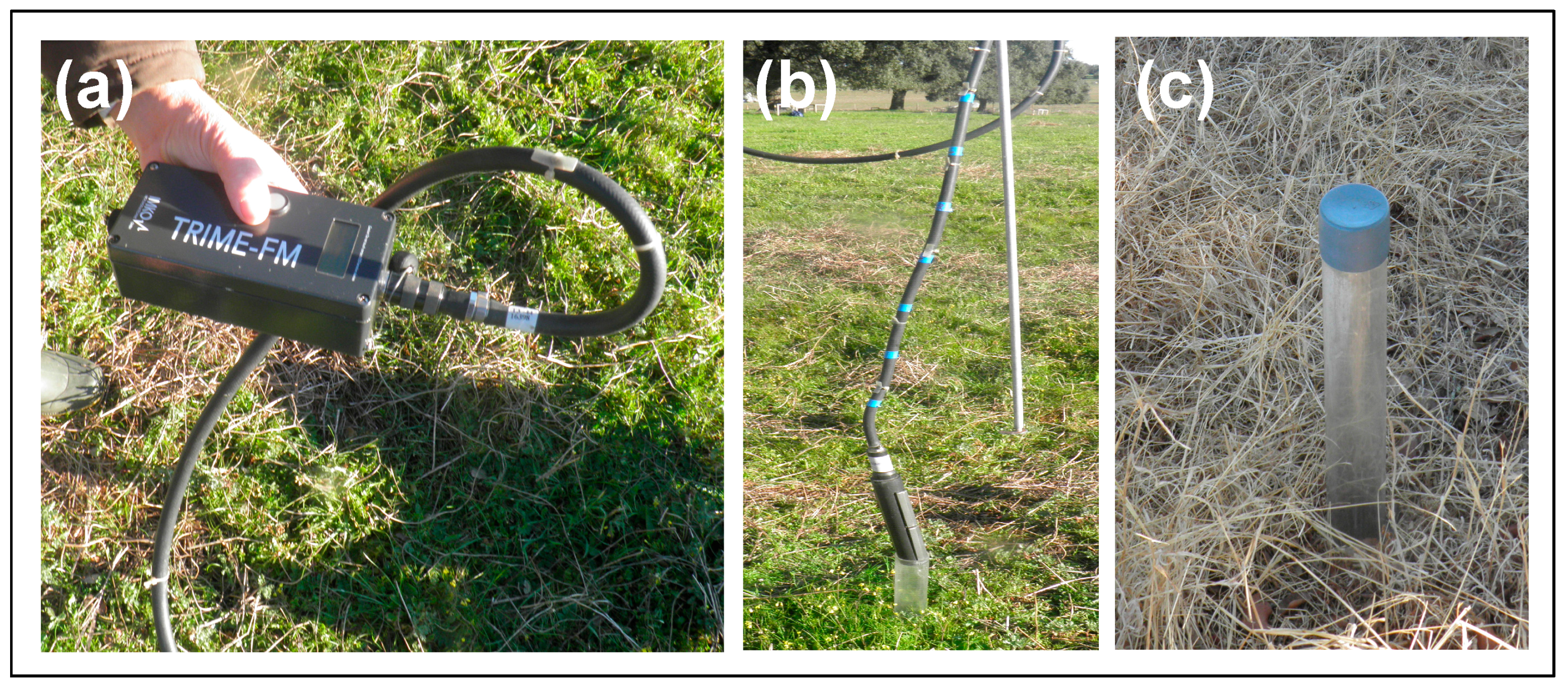
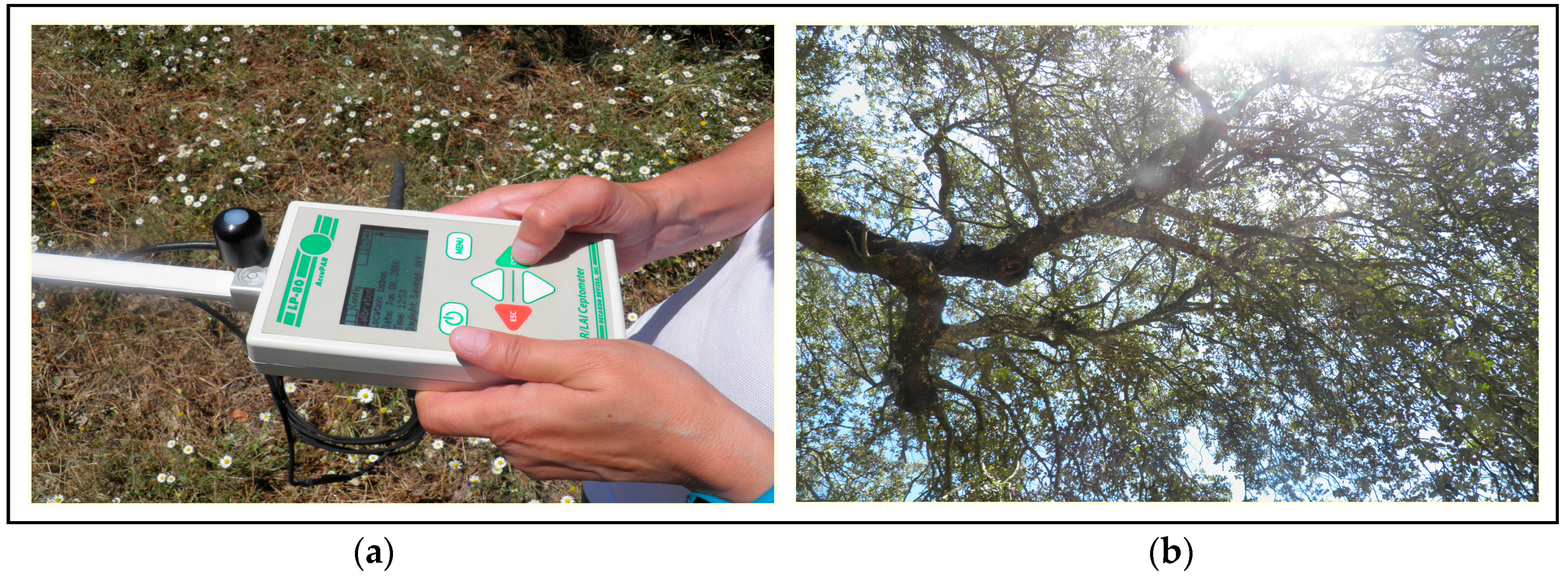
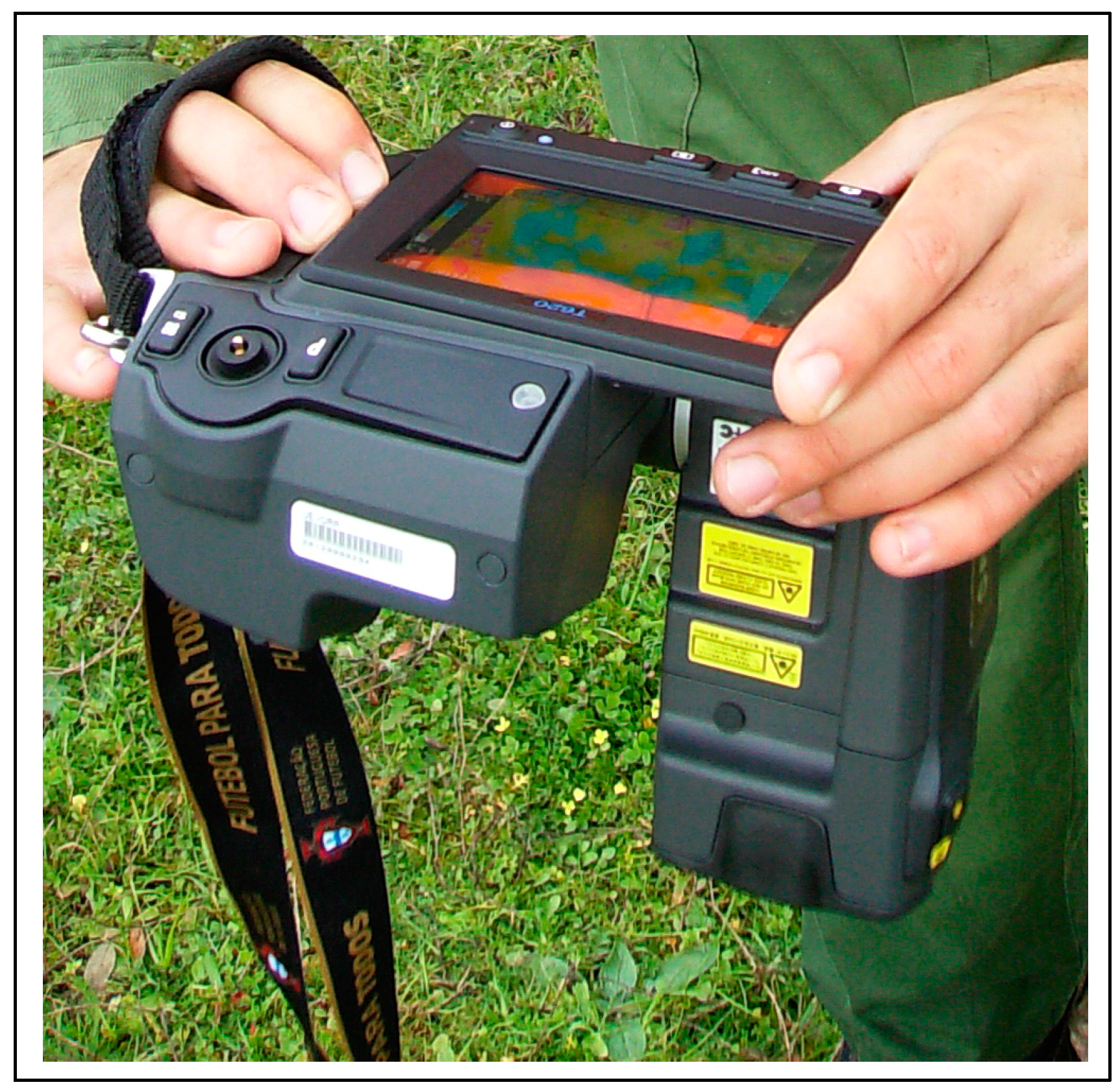
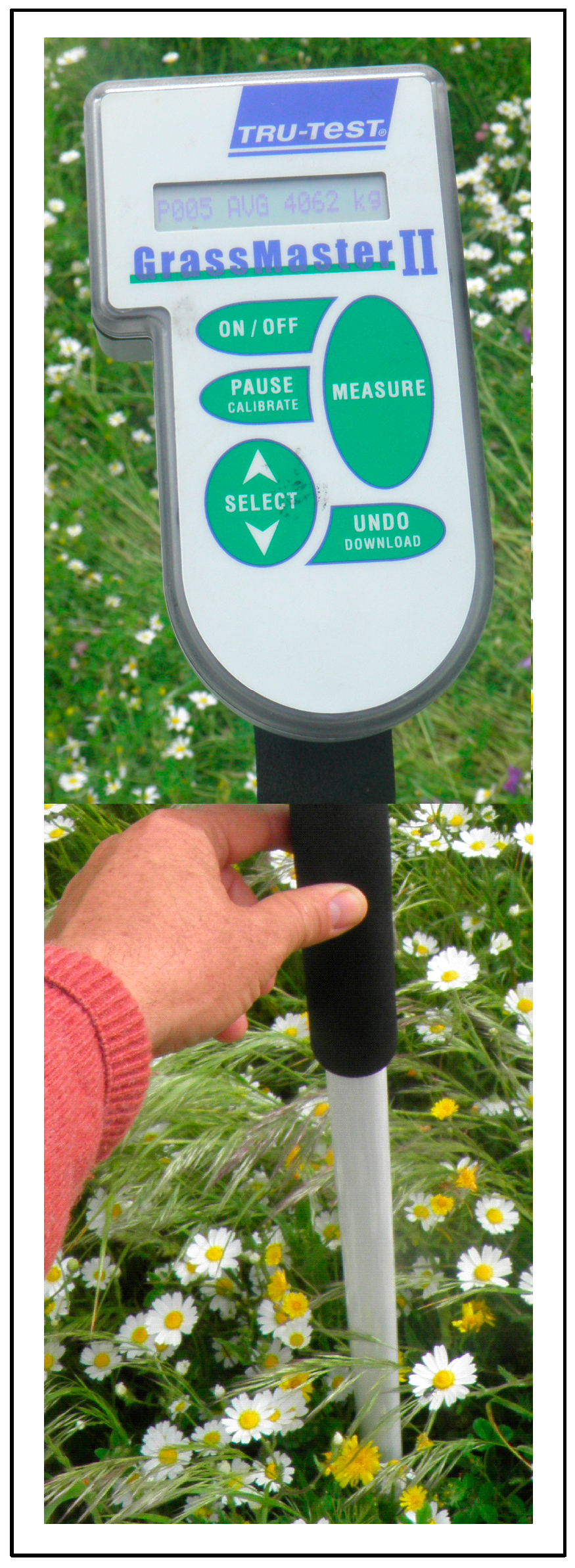

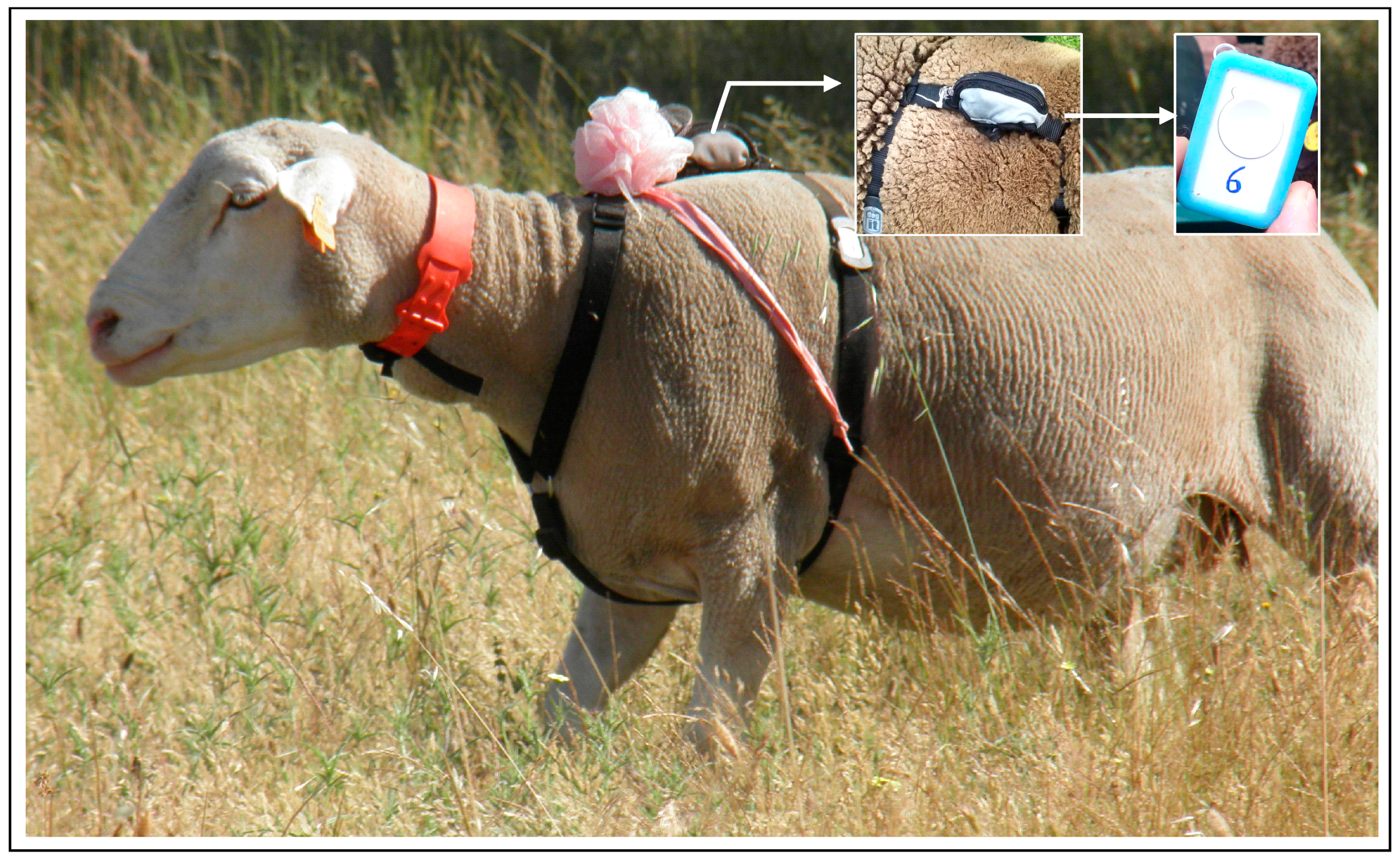
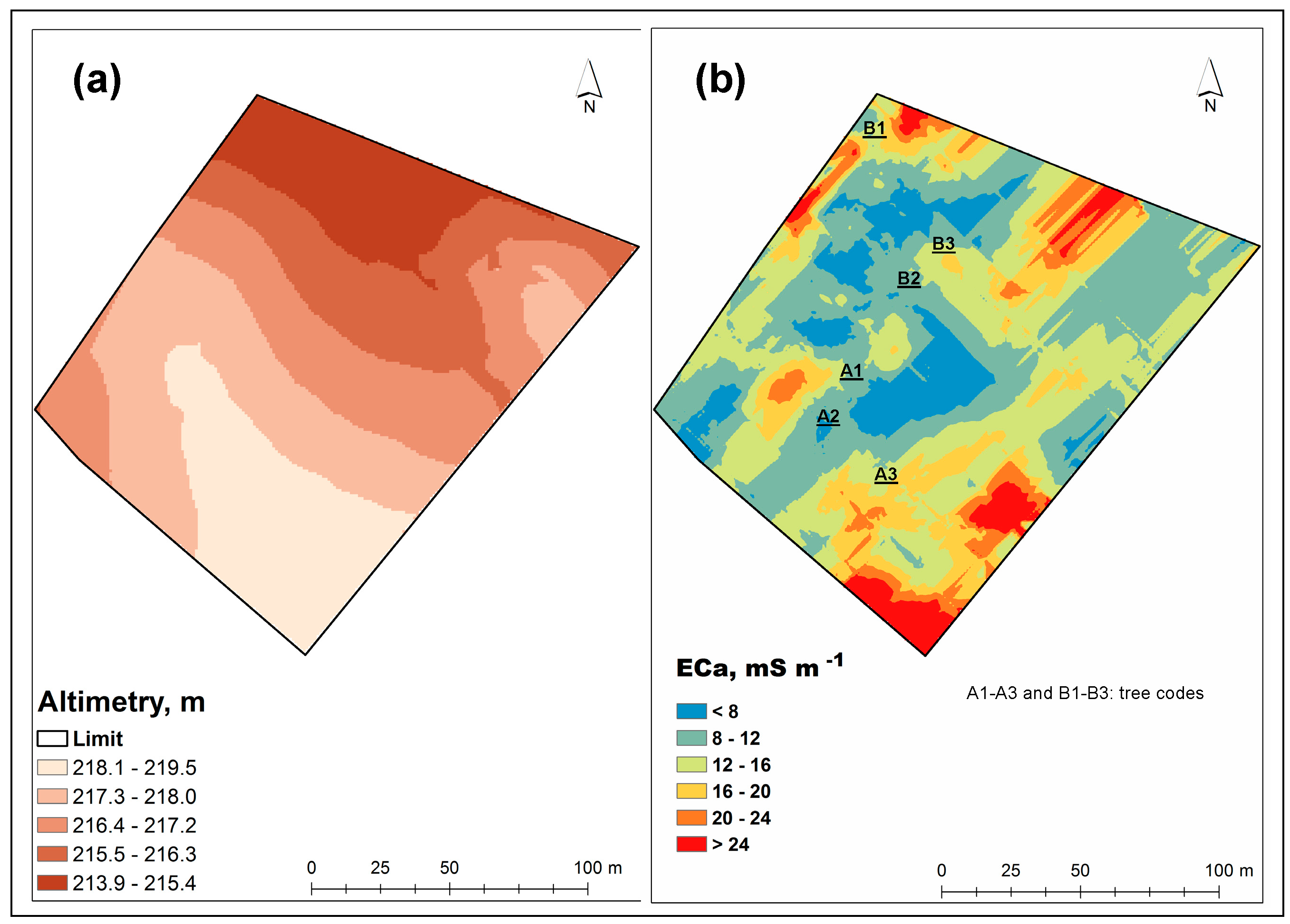
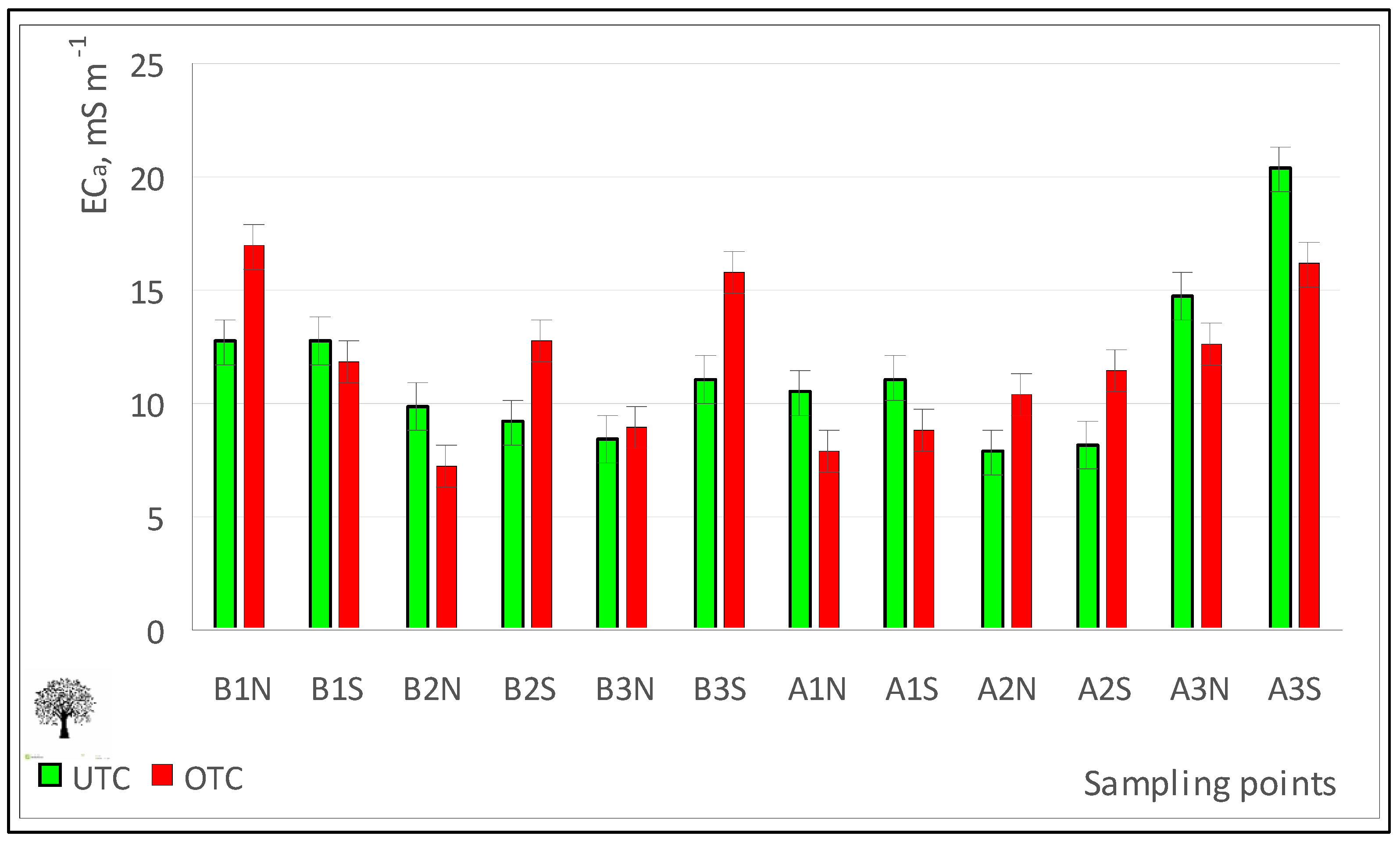
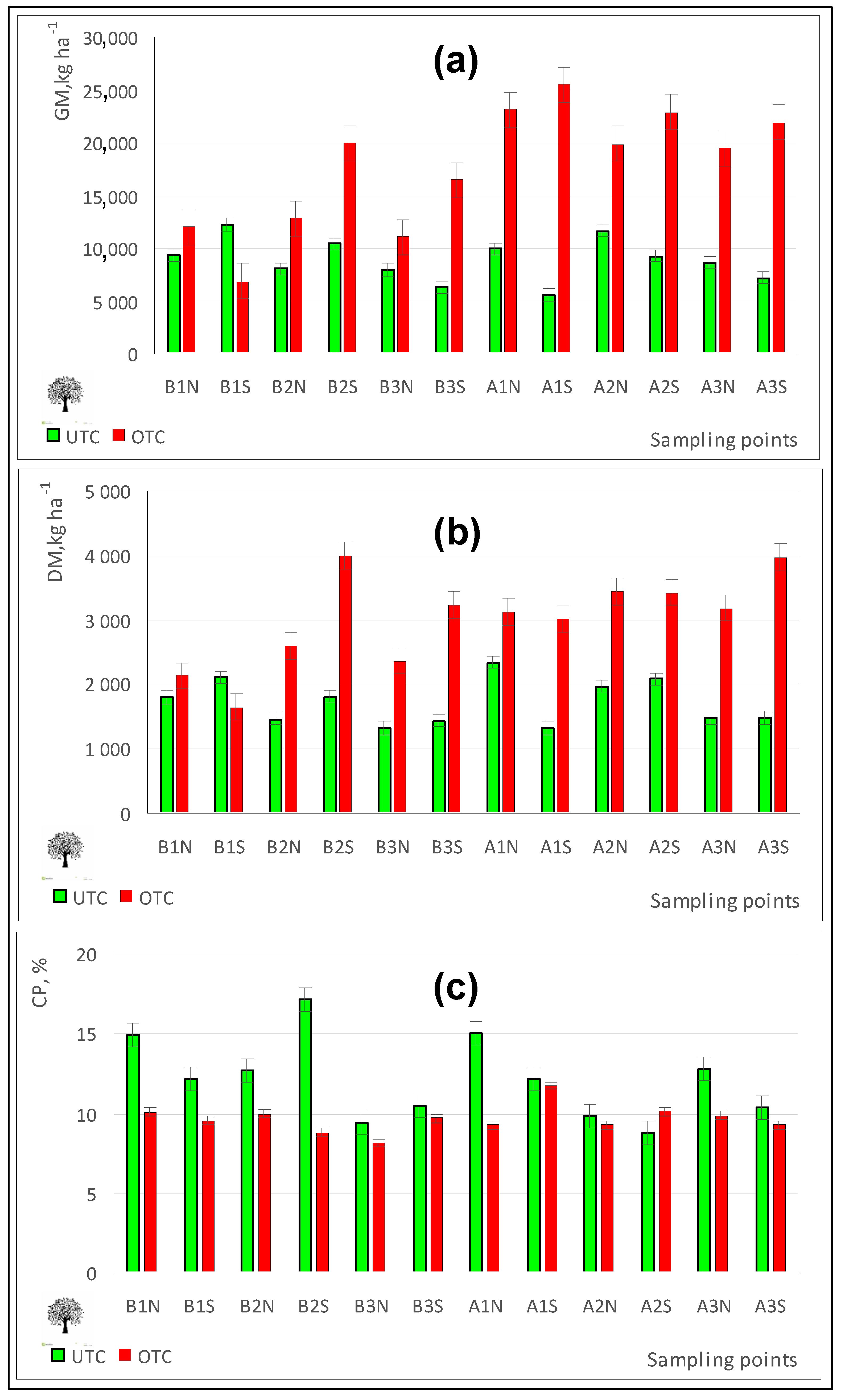
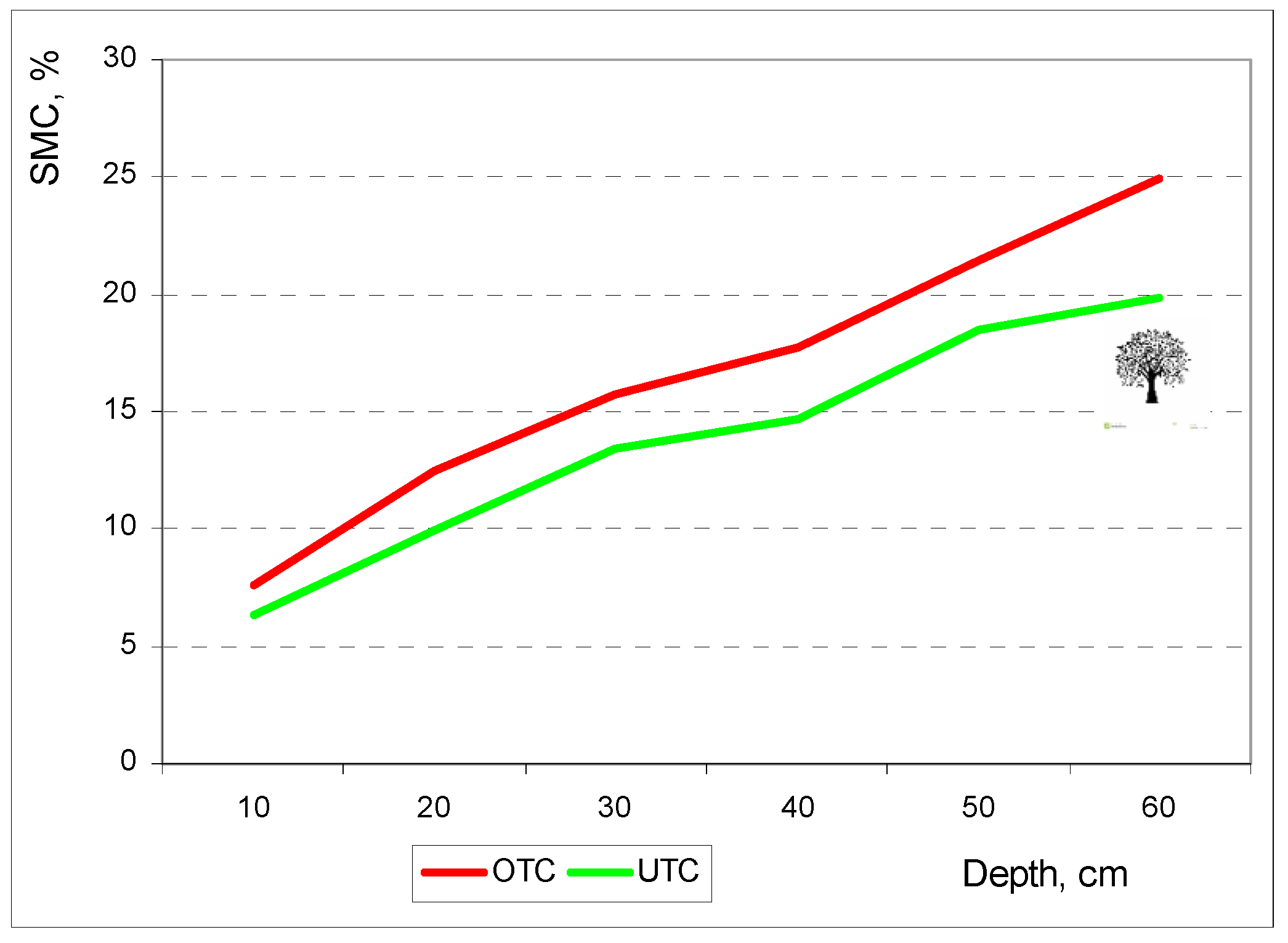
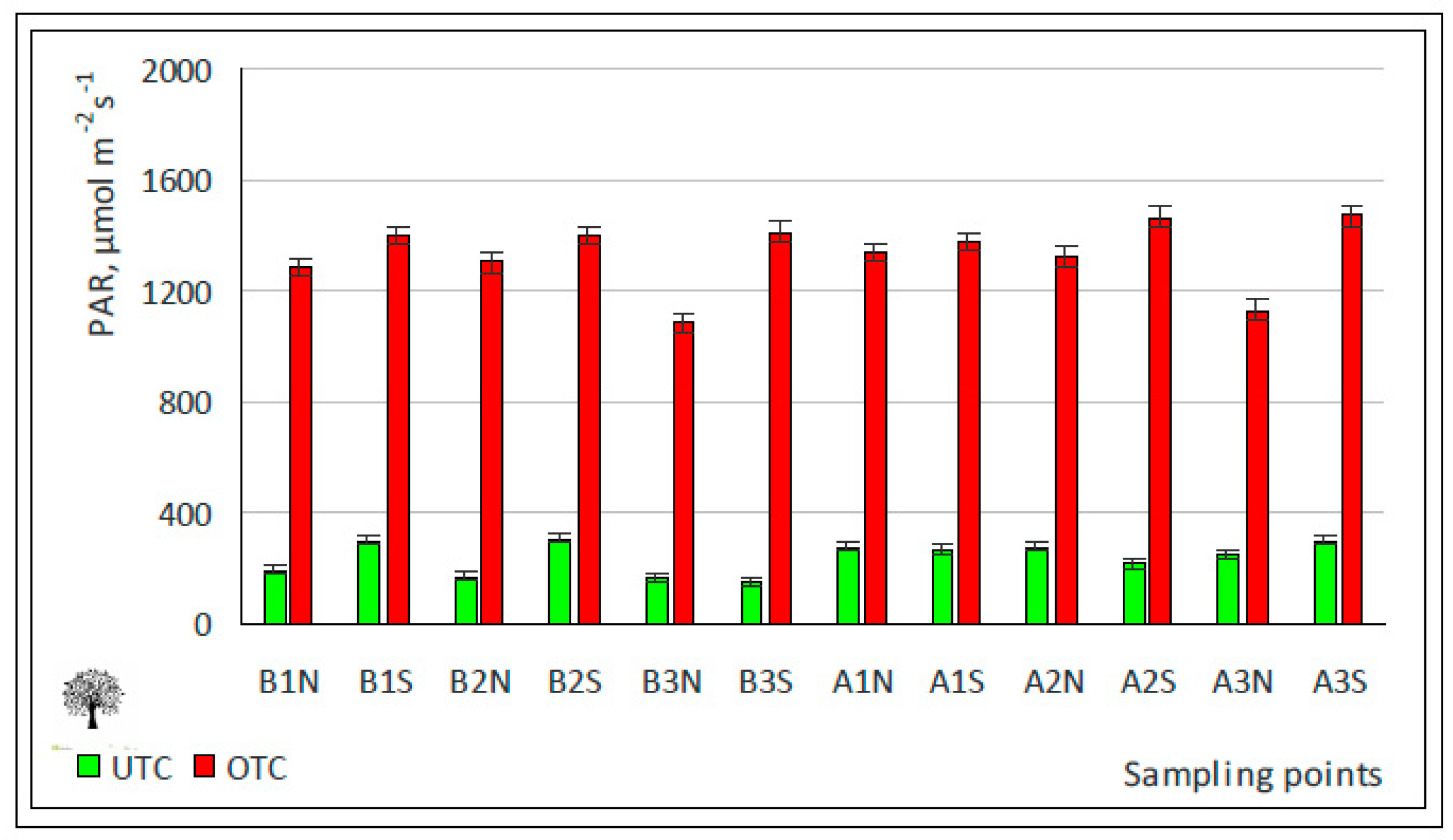
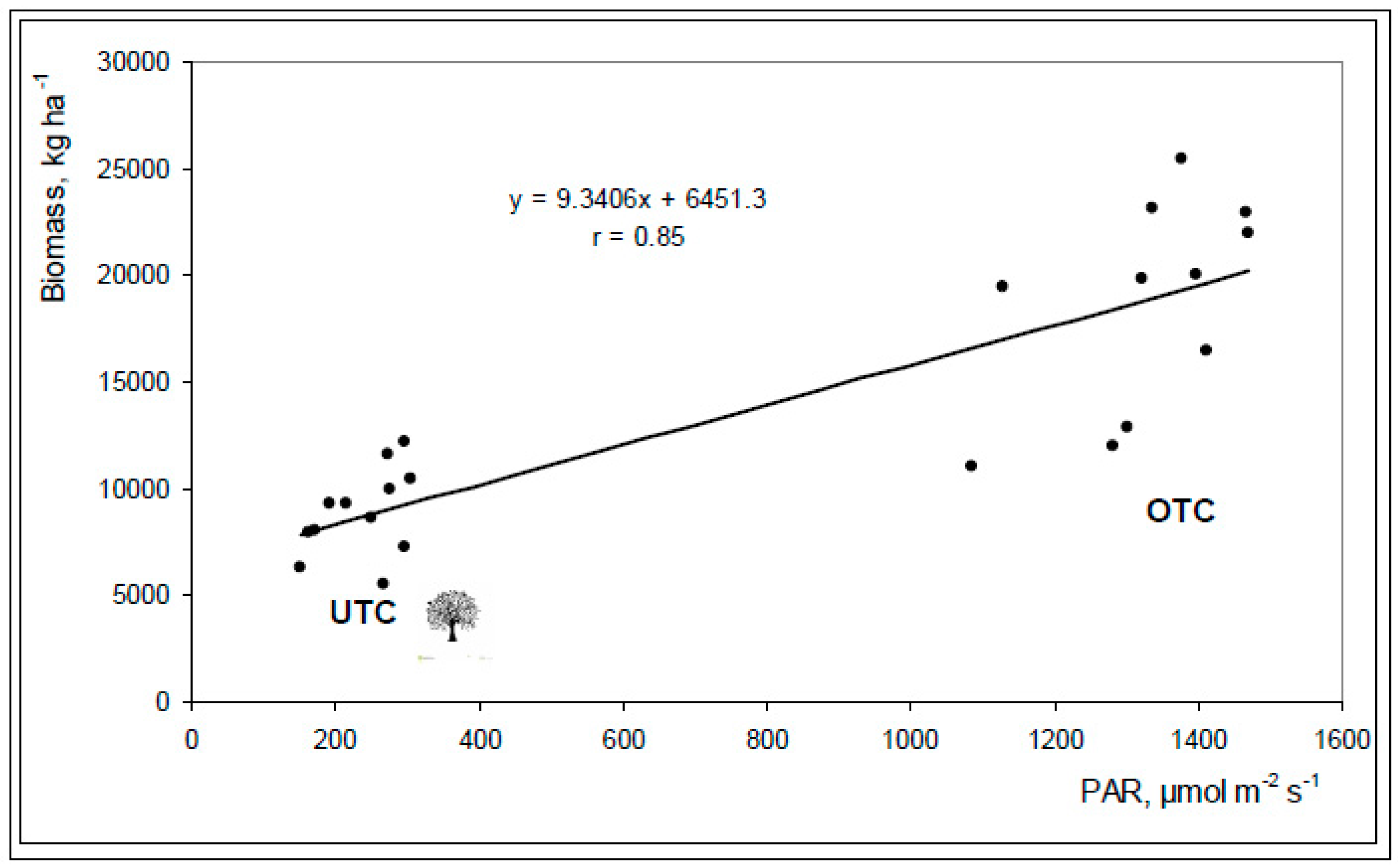
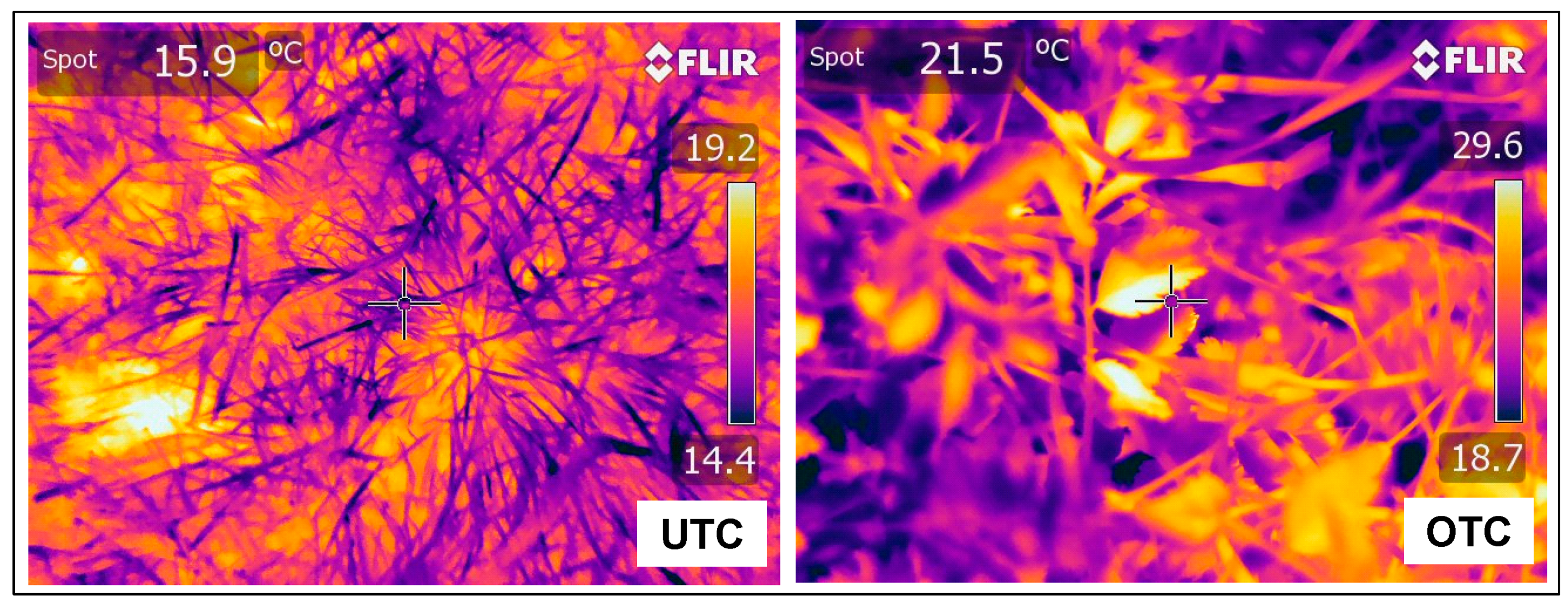
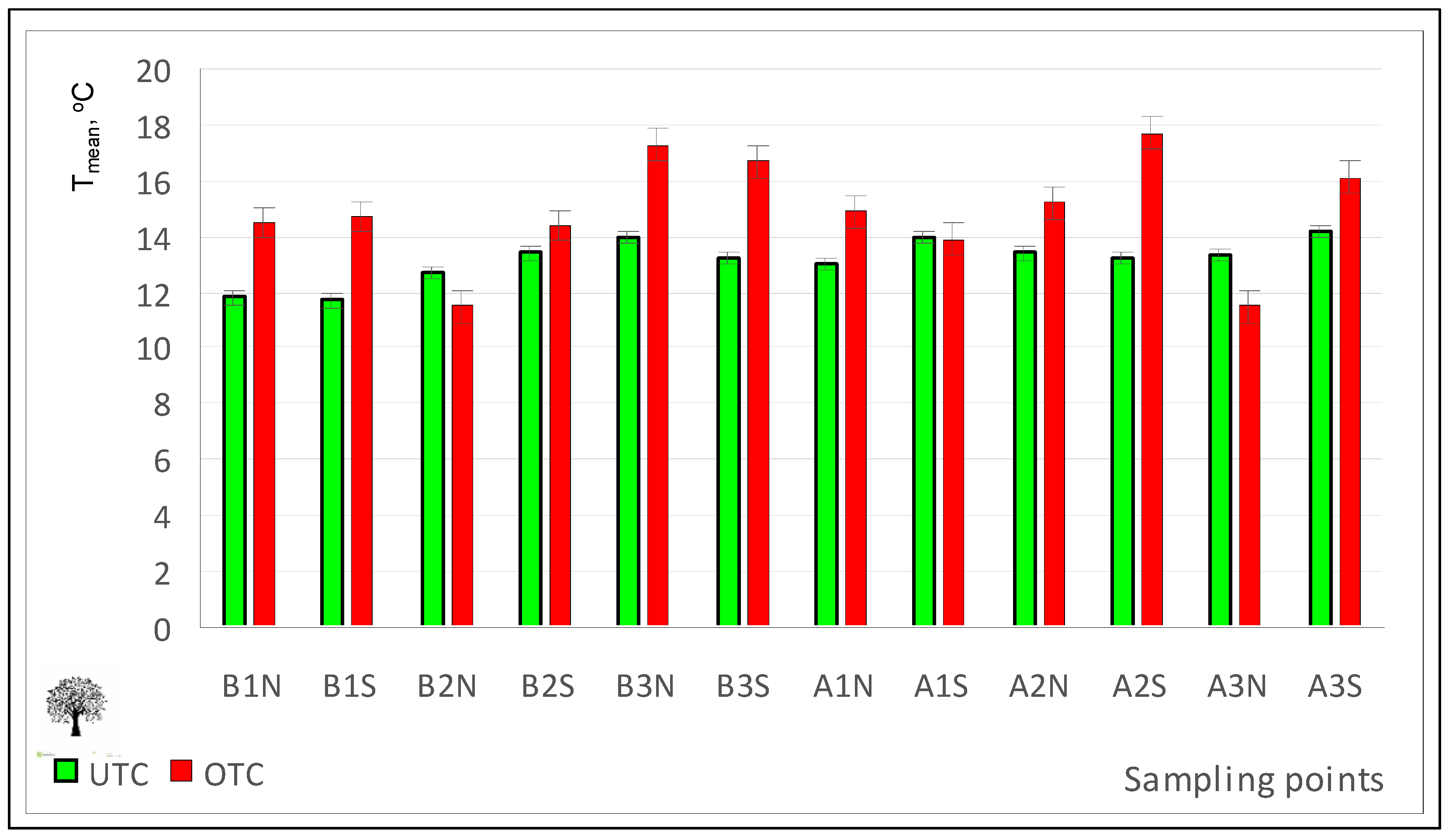
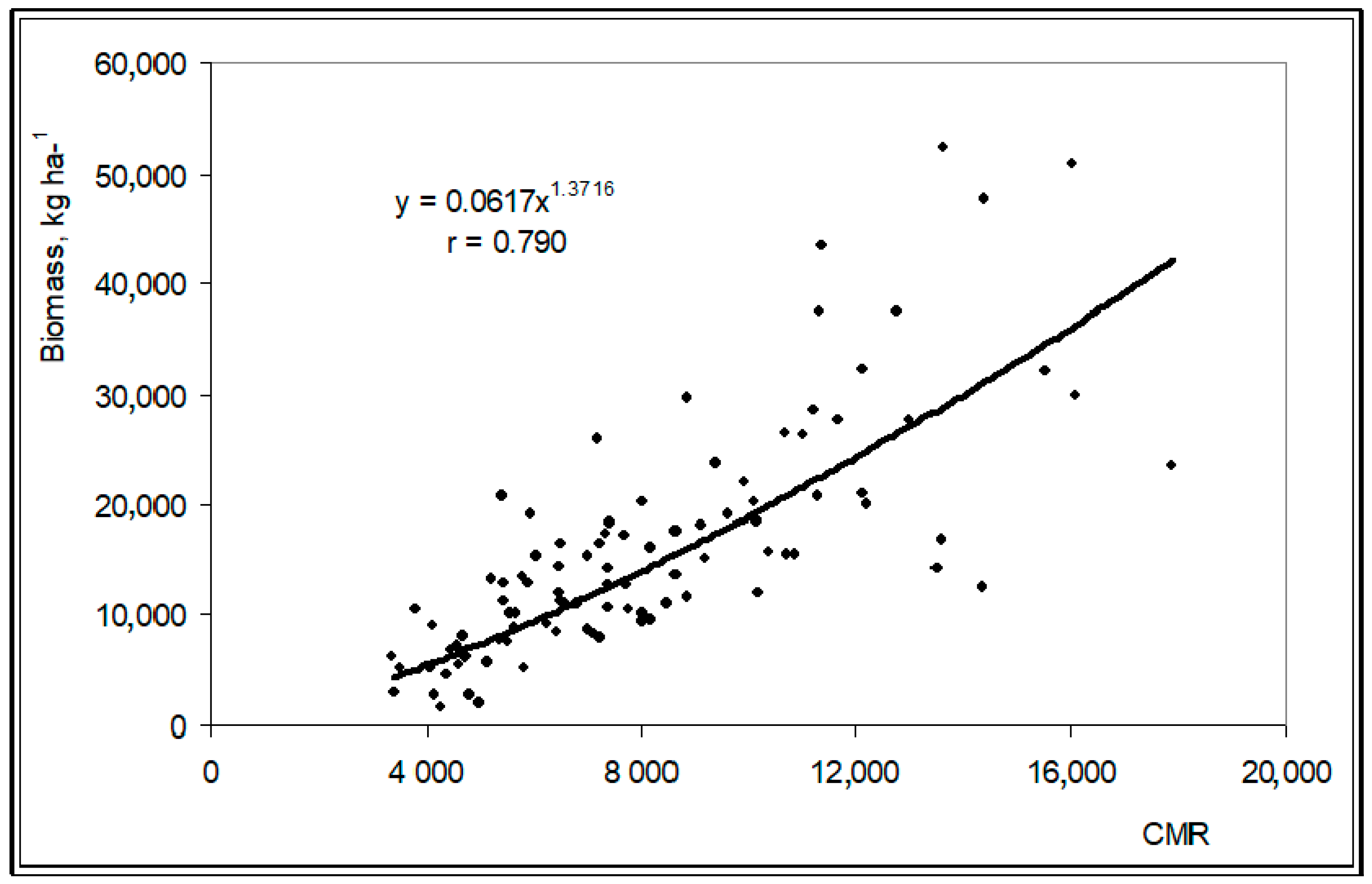
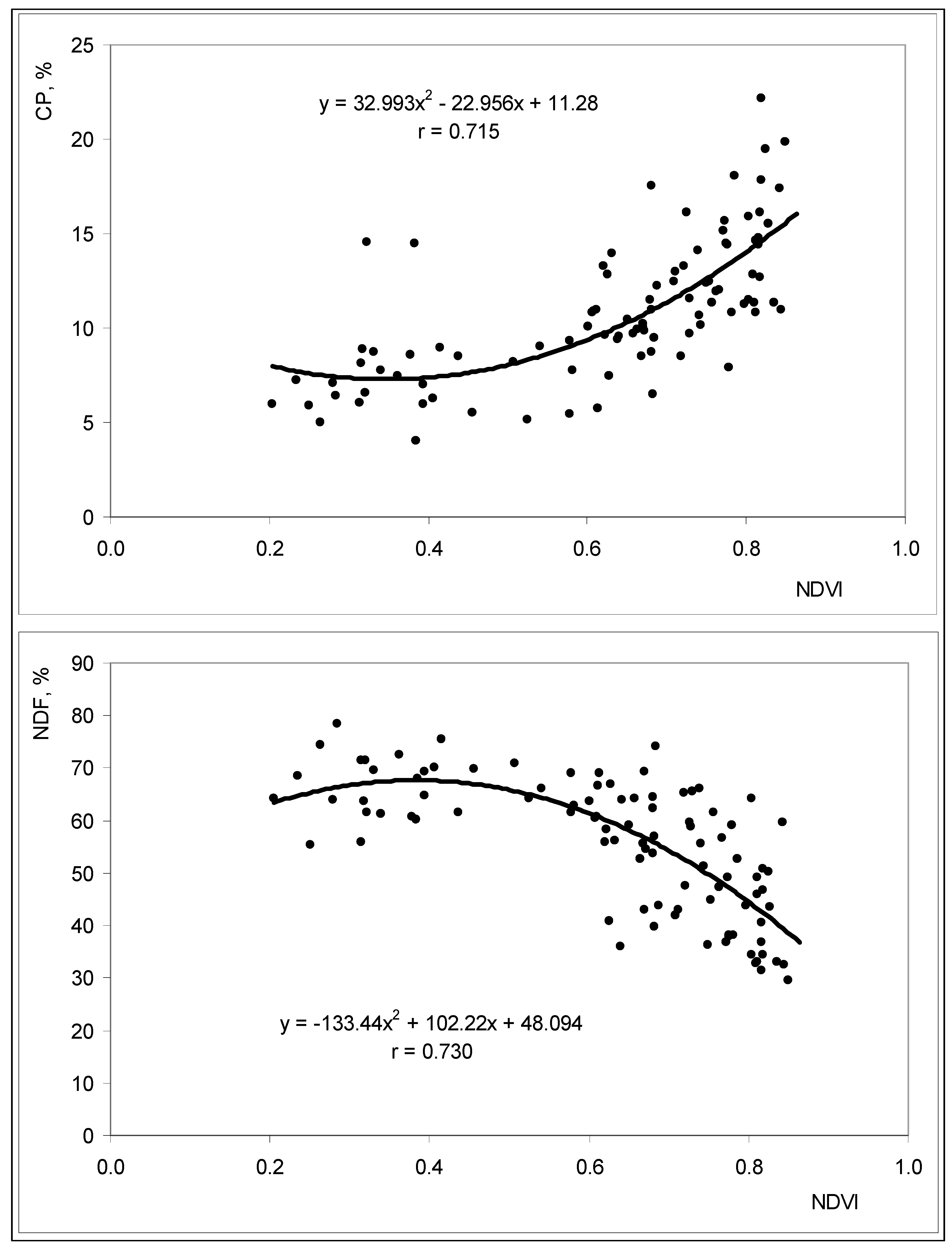
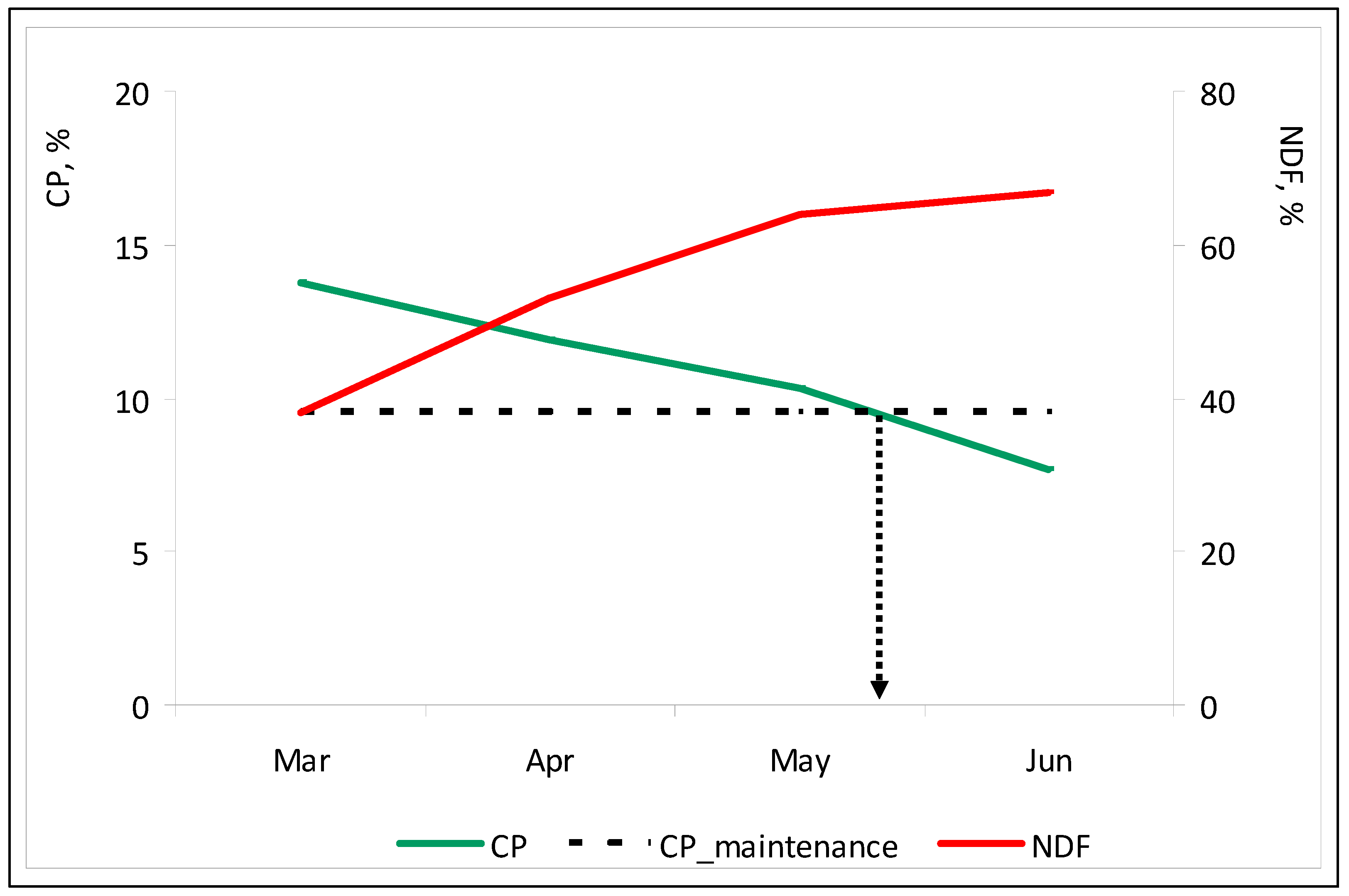
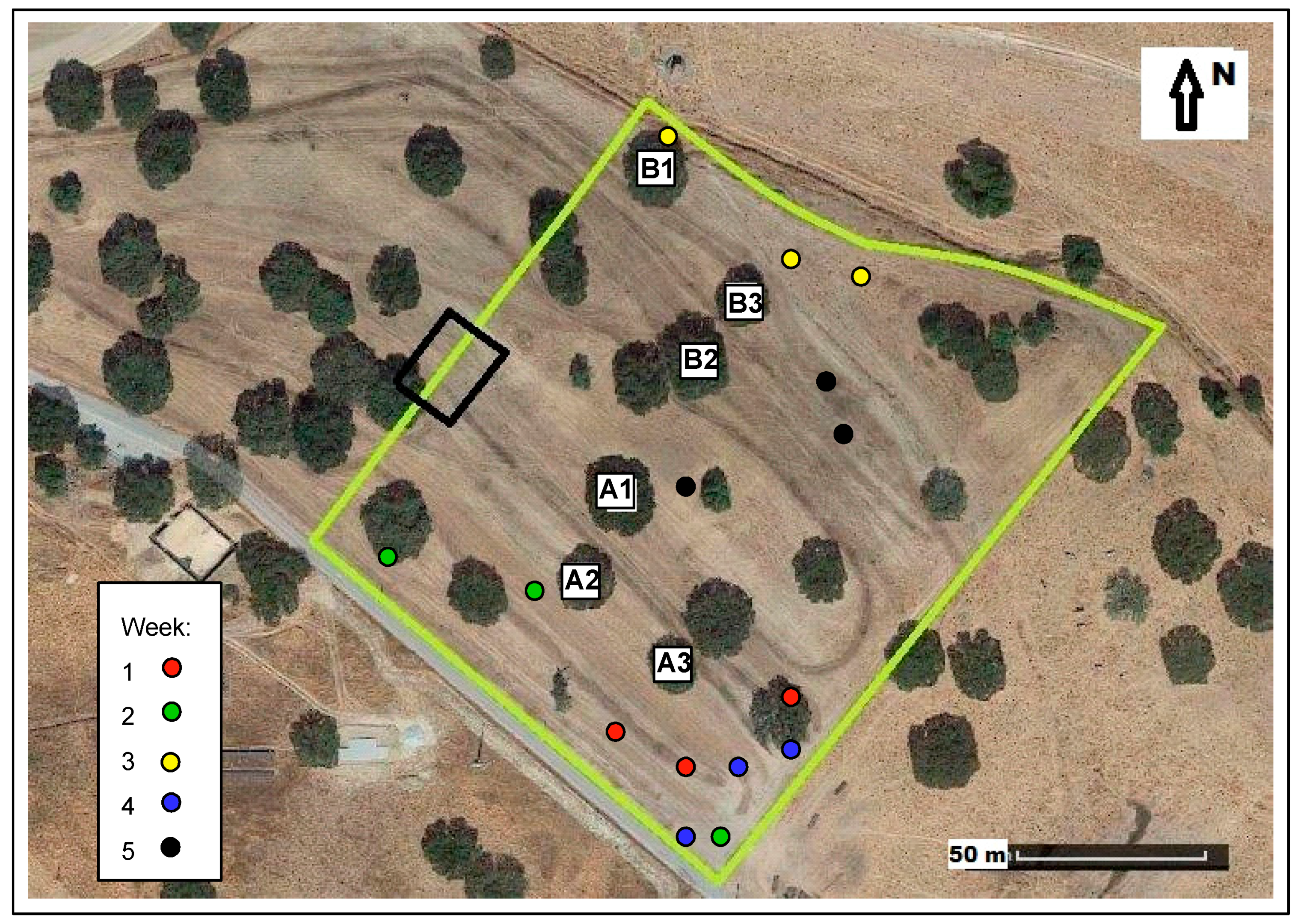
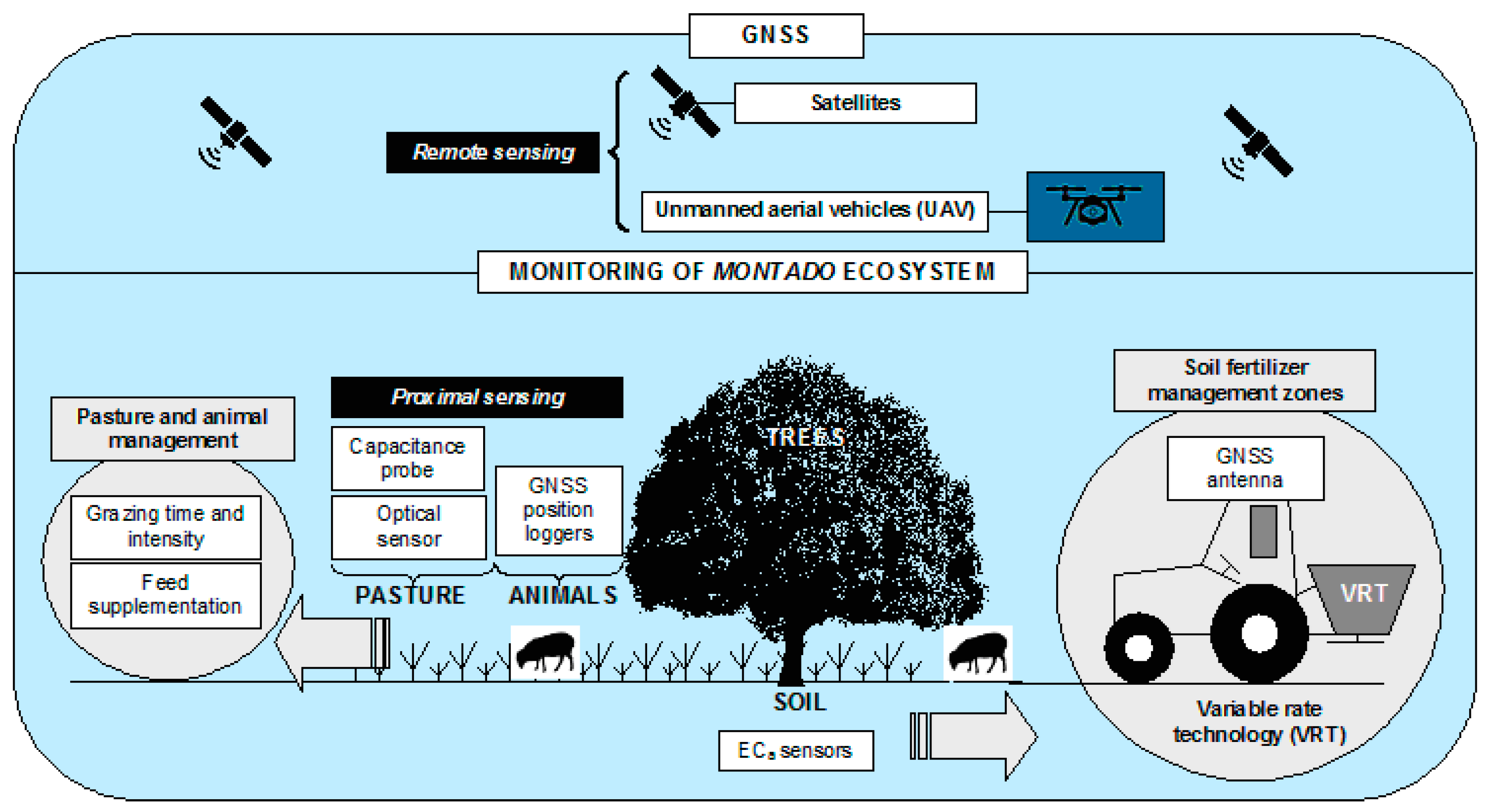
| Parameter | UTC | OTC | Probability |
|---|---|---|---|
| Soil | |||
| ECa, mS m−1 | 11.4 ± 3.5 | 11.7 ± 3.3 | ns |
| SMC, % | |||
| d-0.10 m | 6.4 ± 2.0 | 7.6 ± 2.1 | 0.0032 |
| d-0.20 m | 9.9 ± 3.5 | 12.5 ± 2.6 | 0.0009 |
| d-0.30 m | 13.4 ± 6.7 | 15.7 ± 4.9 | 0.0011 |
| d-0.40 m | 14.7 ± 6.3 | 17.8 ± 7.3 | 0.0020 |
| d-0.50 m | 18.5 ± 5.4 | 21.5 ± 7.4 | 0.0012 |
| d-0.60 m | 19.8 ± 5.6 | 25.0 ± 6.8 | 0.0006 |
| Pasture | |||
| GM, kg ha−1 | 12,402.5 ± 3910.1 | 21,403.3 ± 9127.9 | 0.0002 |
| DM, kg ha−1 | 1804.2 ± 545.5 | 2986.7 ± 1194.5 | 0.0001 |
| CP, % | 13.4 ± 4.2 | 10.5 ± 1.8 | 0.0375 |
| PAR, μmol m−2 s−1 | 239.7 ± 56.5 | 1332.5 ± 121.1 | 0.0000 |
| Tmean, °C | 13.2 ± 0.8 | 14.9 ± 2.0 | 0.0108 |
| CMR | 6994.1 ± 1198.5 | 10,133.9 ± 1552.9 | 0.0000 |
| NDVI | 0.741 ± 0.078 | 0.723 ± 0.050 | 0.0491 |
| Characteristics and Potential Applications | Proximal Sensing | Remote Sensing UAV-Based | Remote Sensing Satellite-Based |
|---|---|---|---|
| Characteristics | |||
| Scale | Low | Medium | High |
| Resolution | High | Medium | Low |
| Cost | High | Medium | Low |
| Perspective of application | |||
| Research | High | High | High |
| Business | Low | Medium | High |
| Potential to differential management | |||
| Soil (fertilizer or correction) | High | Medium | Medium |
| Pasture (resowing of botanical species or rotation of grazing plots) | High | High | High |
| Tree (density or diseases) | Low | High | High |
| Animal (feed supplementation/ tracking) | High/High | High/Low | High/Low |
© 2018 by the authors. Licensee MDPI, Basel, Switzerland. This article is an open access article distributed under the terms and conditions of the Creative Commons Attribution (CC BY) license (http://creativecommons.org/licenses/by/4.0/).
Share and Cite
Serrano, J.; Shahidian, S.; Marques da Silva, J.; De Carvalho, M. A Holistic Approach to the Evaluation of the Montado Ecosystem Using Proximal Sensors. Sensors 2018, 18, 570. https://doi.org/10.3390/s18020570
Serrano J, Shahidian S, Marques da Silva J, De Carvalho M. A Holistic Approach to the Evaluation of the Montado Ecosystem Using Proximal Sensors. Sensors. 2018; 18(2):570. https://doi.org/10.3390/s18020570
Chicago/Turabian StyleSerrano, João, Shakib Shahidian, José Marques da Silva, and Mário De Carvalho. 2018. "A Holistic Approach to the Evaluation of the Montado Ecosystem Using Proximal Sensors" Sensors 18, no. 2: 570. https://doi.org/10.3390/s18020570
APA StyleSerrano, J., Shahidian, S., Marques da Silva, J., & De Carvalho, M. (2018). A Holistic Approach to the Evaluation of the Montado Ecosystem Using Proximal Sensors. Sensors, 18(2), 570. https://doi.org/10.3390/s18020570







